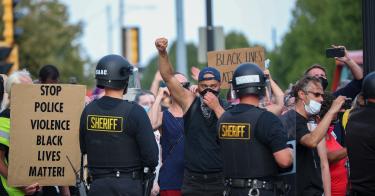Newton's Third Law of Motion states that for every action, there is an equal and opposite reaction.
The famed scientist was referring to physical force, and not to personal interactions. And yet this law also serves as a good guideline for discussions about policing reform. It can remind us why civilian noncompliance matters, and why we have to talk about it.
Yes, even in the case of Jacob Blake.
Every police-involved shooting includes two different parties to the interaction—the civilian and the officer. Yet, too often, when these interactions turn deadly, we look only to the actions of the police officer and pretend that the actions of the civilian had no effect whatsoever.
If we truly want meaningful policing reform, we cannot continue these one-sided discussions that fail to appreciate how and why our actions as civilians so often affect the actions of law enforcement officers.
People who really do not want to be arrested will sometimes take desperate and violent measures. Police encounters with angry, noncompliant individuals can turn into very dangerous situations for officers, and very quickly.
Consider a horrifying police stop in Tulsa, Oklahoma, that occurred just two months before the Blake shooting, It showed precisely why officers are reasonably on heightened alert when civilians, regardless of race, become hostile and noncompliant.
On June 29, officers stopped David Ware, a white man, for several traffic violations that required his vehicle to be towed. Ware refused to exit the car despite being ordered to do so dozens of times (and being stun with a Taser), leading to increasingly physical scuffles with the officers who tried to pull him out. Suddenly, Ware produced a hidden handgun and opened fire on the officers, killing one and seriously wounding another.
This is far from the only case of "mere noncompliance" turning into a life-or-death struggle for officers in just fractions of a second.
There's also the case of Daniel Clary, who in 2018 turned a routine traffic stop into a nightmare for two Pennsylvania state troopers. Clary failed several field sobriety tests after being pulled over for speeding. When Cpl. Seth Kelly and Trooper Ryan Seiple tried to arrest Clary for driving under the influence, he physically assaulted them and a nearly minute-long struggle ensued.
Clary eventually broke away from the officers, reached quickly into his driver's side window, and in just seconds produced the gun with which he would shoot and nearly kill both of them.
Then there's the infamous 1998 case of Deputy Kyle Dinkheller, whose brutal execution at the hands of Andrew Brannan, a white Vietnam vet, was caught on a dashcam video that has since been routinely used to train new officers.
Brannan became belligerent during a traffic stop, aggressively approaching the deputy to the point where Dinkheller radioed for assistance and grabbed his police baton for protection. Brannan then walked back to his truck and quickly pulled out an M1 carbine from under the driver's seat.
He would use that rifle to shoot Dinkheller nine times, disabling him. The video captures Dinkheller's heart-rending pleas for his life as he lay helpless on the asphalt. Brannan shot him in the head. He wound up on death row and was executed in 2015.
But, some ask, what about the fact that Jacob Blake's kids were in the car? Only two years earlier in Milwaukee, just 45 minutes from Kenosha, Mario Hobson, wanted for active felony domestic violence warrants, fled from a traffic stop. When police later responded to a tip about the location of Hobson's vehicle, they found him still in the back seat, along with several children. Hobson was so desperate to avoid arrest that he drew a firearm and died in a hail of bullets. The lives of those children evidently meant nothing to him.
I don't know what Officer Rusten Sheskey saw or thought he saw in the moments before he shot Jacob Blake seven times as the suspect reached into his driver's side door. I don't know whether there is enough public evidence to conclude that Sheskey's actions were perfectly reasonable or entirely justified.
I do know that when I first saw the video of an irate Blake storming toward his vehicle, failing to comply with the demands of an officer with his gun drawn, a hundred different images of violence against officers flashed in my mind.
I know there was an officer whose actions were in large part a response to having arrived at a domestic dispute call with a man he knew had outstanding felony warrants. I know Blake was so adamant about not being arrested that he physically assaulted officers, brushed off a Taser, and stormed angrily toward a car where no one knew what weapons might be hidden.
Like most people, I want to live in a world where law enforcement officers are both well-trained to act reasonably and held accountable for their unreasonable actions.
But we can't create this world unless we understand and appreciate why civilian noncompliance places officers in a state of heightened alert.
Let's start with an honest conversation about Jacob Blake's actions and their role in the equation.
This piece originally appeared in ArcaMax




